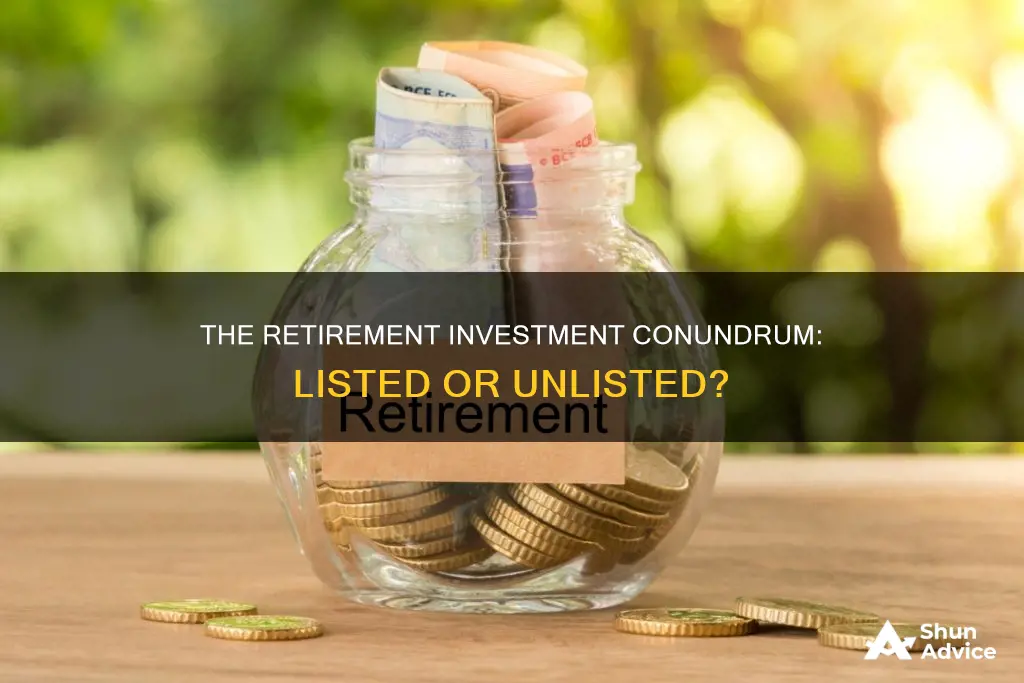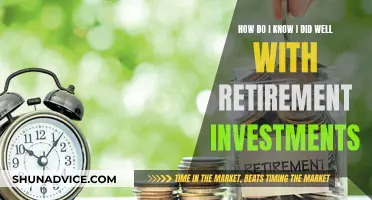
When it comes to retirement investments, it's important to understand the difference between listed and unlisted assets. Listed investments are those that are traded regularly on a formal exchange or market, such as the New York Stock Exchange (NYSE) or the Australian Securities Exchange (ASX). On the other hand, unlisted investments are not traded on a public exchange and include private equity, property, infrastructure, and debt. Unlisted assets are considered long-term investments and are useful for super funds aiming to assist members in saving for retirement. They provide benefits such as diversification, steadier income streams, and good risk-adjusted returns. However, it's important to note that unlisted investments also come with higher risks and lower liquidity.
| Characteristics | Values |
|---|---|
| Definition | Investments that are traded on a formal exchange |
| vs. those that are not | |
| Examples of listed investments | Shares, bonds, exchange-traded funds, options |
| Examples of unlisted investments | Private equity, property, property syndicates, unlisted funds |
| Trading frequency | Listed investments are traded regularly and continuously |
| when the market is open | |
| Unlisted investments are traded infrequently or in a restricted way | |
| Liquidity | Higher for listed investments |
| Volatility | More observable for listed investments |
| Unlisted investments can still change significantly in value | |
| Costs | Unlisted investments have lower costs due to no listing or share registry fees |
| Listed investments are less tax-efficient | |
| Risk | Unlisted investments are considered higher risk |
| and may be of lower quality |
What You'll Learn
- Listed assets are shares that can be easily bought and sold in a market exchange environment
- Unlisted assets are investments that aren't listed on an exchange, like real estate
- Unlisted securities are financial instruments not traded on a formal exchange
- Unlisted investments are generally considered high-risk
- Unlisted assets are priced less frequently than listed assets

Listed assets are shares that can be easily bought and sold in a market exchange environment
Retirement investments can be made in listed or unlisted assets, and it is important to understand the differences between the two. Listed assets are shares that can be easily bought and sold in a market exchange environment. They are traded on a formal exchange, such as the New York Stock Exchange (NYSE) or Nasdaq, and are subject to strict regulations. Listed assets include stocks, debentures, and other financial instruments that meet the listing requirements of the exchange. For example, to be listed on the NYSE, a company must surpass an annual income or market capitalization threshold, issue a specific number of shares, and be able to afford the listing fee. These requirements ensure that only high-quality companies trade on these exchanges, providing some security for investors.
Listed assets can be bought and sold regularly via a public exchange or market, such as the Australian Securities Exchange (ASX). They are open to being traded and provide investors with the opportunity to gain from potential increases in value over time. However, the values of listed assets are subject to the ups and downs of investment market cycles, which can lead to large valuation changes over short periods.
Listed assets are typically traded through online platforms or broker apps, and the minimum investment amount is generally low. For example, in some cases, investors can start with a minimum of one share. Additionally, listed assets provide an easy and immediate exit route for investors, allowing them to sell their shares at any time if they find a buyer. This liquidity is a significant advantage of listed assets over unlisted ones.
It is important to note that listed assets are subject to strict regulations, such as those imposed by the Securities and Exchange Board of India (SEBI) in India. These regulations ensure transparency and protect investors' interests. Listed companies are required to regularly share financial information, providing potential investors with the data they need to make informed decisions.
In summary, listed assets are shares that can be easily bought and sold on formal exchanges or markets. They are subject to regulations that ensure transparency and provide some level of security for investors. The ease of trading, liquidity, and potential for gains make listed assets a popular choice for investors, including those planning for retirement. However, it is crucial to remember that the values of listed assets can fluctuate significantly, and investors should carefully consider their financial goals and risk tolerance before making any investment decisions.
Residential Investment Dividends: Unlocking the Payout Frequency Mystery
You may want to see also

Unlisted assets are investments that aren't listed on an exchange, like real estate
Unlisted assets are investments that are not traded through a public exchange or market. They are often referred to as OTC (over-the-counter) securities, as they are traded on the OTC market, mostly by market makers or dealers. Unlisted securities are usually issued by smaller or new firms that cannot or do not want to comply with the requirements of an official exchange, such as market capitalization thresholds or listing fees.
The most common types of unlisted assets include unlisted property, unlisted infrastructure (such as roads, power grids, rail, ports, airports, and utilities), private equity, and private credit. Private equity investments provide money for private companies that are not listed or publicly traded. Private credit, on the other hand, involves providing loans to fund opportunities such as commercial real estate construction or infrastructure assets.
Unlisted assets can be directly owned by investors or co-owned with others through an unlisted trust. Unlisted trusts can vary in size and scope, from small property syndicates investing in a single property to large trusts owning major CBD office buildings, shopping malls, hotels, or airports.
It is important to note that unlisted assets are generally considered high-risk investments. They are often less liquid than listed securities, and there may be challenges in finding buyers or selling them at a fair price. Additionally, the value of unlisted assets may be subject to dilution as the company issues more shares, potentially reducing the percentage of the company owned by existing shareholders.
Kodak Stock: Buy or Pass?
You may want to see also

Unlisted securities are financial instruments not traded on a formal exchange
Unlisted securities are financial instruments that are not traded on a formal exchange, such as the New York Stock Exchange (NYSE) or Nasdaq. They are often referred to as over-the-counter (OTC) securities, as they are traded on the OTC market, which is a decentralised market where participants trade directly with one another without the oversight of an exchange. Market makers or dealers facilitate the buying and selling of unlisted securities on the OTC market.
Unlisted securities are typically issued by smaller or new firms that cannot or do not wish to comply with the requirements of an official exchange. For example, to be listed on the NYSE, a company must surpass an annual income or market capitalisation threshold, issue a specific number of shares, and be able to afford the exchange's listing fee. Unlisted securities may be of lower quality and present a greater risk to investors due to the reduced or eliminated size and other requirements for companies.
The most common type of unlisted security is common stock, often traded on the Over-The-Counter Bulletin Board (OTCBB) or the pink sheets. This includes penny stocks, which trade for extremely low prices, and some legitimate foreign companies that don't wish to file reports with the Securities and Exchange Commission (SEC). There are also many unlisted non-stock instruments, including corporate bonds, government securities, and certain derivative products such as swaps traded in the OTC market.
Unlisted securities carry higher risks than listed securities. Some unlisted companies may be undercapitalised, have highly risky business plans, or be no more than an idea without a concrete plan for success. Unlisted transactions also carry counterparty risk, liquidity concerns, and interconnection risks. For example, one side may renege on the contract, and since there is no formal exchange or clearing mechanism, the reputation of dealers and counterparties is crucial in ensuring that all obligations of the transactions are fulfilled.
Unlisted investments, or unquoted investments, are investments in shares of companies or assets that are not traded on the open market. These companies are generally small but have ambitious plans for rapid growth and need investments to scale their business. As they are considered high-risk by traditional financial institutions, they may have difficulty obtaining finance. One alternative source of funding for these companies is private equity from individual investors and funds invested directly in the companies.
Young People: Invest Now, Gain Later
You may want to see also

Unlisted investments are generally considered high-risk
The risks associated with investing are typically magnified with unlisted securities. The reduced or eliminated size and other requirements for companies mean that some unlisted companies may be undercapitalized, have highly risky business plans, or be nothing more than an idea without a concrete plan for success. This makes the potential for losses much higher, and the Financial Conduct Authority (FCA) considers this type of investment to be high-risk.
Another key risk of unlisted investments is the possibility of losing all the money invested. Start-up businesses, which are common recipients of unlisted investments, have a high failure rate, and investors are likely to lose 100% of their investment if the business fails. Additionally, investors are unlikely to be protected in the event of something going wrong, as poor investment performance is not covered by the Financial Services Compensation Scheme (FSCS) or the Financial Ombudsman Service (FOS).
Unlisted investments also present liquidity concerns. Investors may not be able to sell their shares on the open market and may have to wait several years to get their money back, even if the business is successful. The most common way to retrieve the investment is if the business is bought by another company or lists its shares on a stock exchange, but these events are uncommon.
Furthermore, the value of an investor's holdings in an unlisted company may be diluted over time as the company issues more shares to raise additional finance. This can reduce the percentage of the company owned by existing shareholders and decrease the value of their investment.
While unlisted investments carry significant risks, they also offer the potential for high returns if the company becomes successful. Investors should carefully consider the risks and ensure they are financially prepared to absorb any losses before investing in unlisted companies.
International Investments: Retirement's Missing Puzzle Piece?
You may want to see also

Unlisted assets are priced less frequently than listed assets
Unlisted assets are investments that are not traded through a public exchange or market. They are not listed on a secondary (public) market and are usually held for a longer duration. Unlisted assets are priced less frequently than listed assets, which are traded daily on exchanges like the Australian Securities Exchange (ASX).
Unlisted assets are typically valued at set intervals, such as quarterly or annually, and their prices are based on the capital value of the underlying assets. On the other hand, listed assets are valued daily as investors decide how much they are willing to pay based on the company's future profit potential. This results in listed assets being subject to more frequent price fluctuations, influenced by market sentiment and short-term economic changes.
The less frequent pricing of unlisted assets can lead to a lag in reflecting changes in economic, competitive, and market conditions. For instance, some funds used March quarter valuations for their unlisted assets, missing significant volatility in private equity markets during the final months of the financial year. This timing difference can result in a delay in capturing the impact of economic shifts on unlisted asset prices.
Additionally, the valuation process for unlisted assets can be more opaque and subjective. While unlisted assets are independently valued by third-party experts, the valuation reports are often not publicly available. This lack of transparency can make it challenging for investors to understand the assumptions and methodologies underlying the valuations.
In summary, unlisted assets are priced less frequently than listed assets due to their nature of being traded outside public exchanges. This leads to differences in how their values are determined and how quickly they reflect market changes. However, it's important to note that unlisted assets offer benefits such as diversification, lower volatility, and a long-term focus, making them attractive investment options for many individuals and superannuation funds.
Smart Ways to Invest $5,000 Today
You may want to see also
Frequently asked questions
Listed investments are those available for regular trading via a share market, such as the New York Stock Exchange (NYSE) or the New Zealand Stock Exchange (NZX). Unlisted investments are those that are not traded on a stock exchange.
Types of listed investments include bonds, shares, exchange-traded funds, and options. Unlisted investments include private equity, property investing, property syndicates, and unlisted funds.
Unlisted investments can offer tax incentives, diversification, and steadier income streams. They can also be more efficient in claiming international tax credits and paying less tax on distributions.
Unlisted investments are considered high-risk as there is a potential for loss of capital invested. They also have lower liquidity, making it difficult to trade shares on the open market.







